
3
THE STREET KNIFE
A lot of books have been written about fighting knives. They’ve discussed the Bowies,

A historic Bowie knife, 16 inches overall length.
From The Antique Bowie Knife Book, Norm Flayderman collection
the Fairbairn-Sykes,

Reproduction Fairbairn-Sykes, 11½ inches overall length. HRC612
the kukri—in short, the “glamour” knives. “Street” knives are usually dismissed in a short paragraph, if they’re mentioned at all. This always struck me as odd, since there have probably been more people killed or injured with these knives than any other.
Fighting knives can be broken down into two categories. The large sheath knives that are worn openly and the smaller concealed weapon types. It is not my purpose to deal with fighting knives in general in this book, but only with the smaller types. The larger knives have a method of use that is all their own. Techniques that work with a full-sized blade will not work with a small knife. There is obviously some overlap, and no expert can tell you exactly where the cutoff in size lies. But there is enough of a difference to warrant a separate study and explanation.
Street knives can be broken down into two categories: the folder
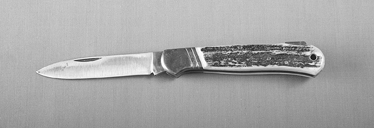
A typical folding pocket knife, 7¾ inches overall length. HRC616
and the small sheath knife.

A small concealable boot knife, 6¾ inches overall length. HRC32
Push daggers would fall into the latter category, although they are generally less versatile than any of the others.
Folders have always been the most prevalent and the reason is obvious. You might talk a judge or cop out of a concealed weapons charge if all you’re carrying is a pocket knife. It’s much harder to do that when you have a small dagger that is obviously intended only as a weapon. A folder is also cheaper and can be thrown away with much less of a financial loss.
The perennial favorite of the Hollywood Bad Guy is the switchblade. The movies were very successful in establishing this as the ultimate weapon of the juvenile delinquent. They were so successful, the things were banned and it’s damned near impossible to find one nowadays. Knifings still continued at the same old pace and that should tell people something.
In the movies, Bad Guys always opened their knives with a very loud and menacing click. Now, this “click” has always impressed a certain type of knife carrier. He might not have an idea what to do with a knife, and he almost always would be better off if he could open the thing without attracting attention. But no. He wants the knife to produce a very loud click when it opens. It’s the same type of mentality that judges a car by the way the door slams. The durn thing may not have much of a motor, but if the door closes with a solid thunk . . .
Ninety-nine percent of the switchblades I’ve seen were the edged-weapon version of the Saturday Night Special, not even worth the single buck they usually cost. Just cheap, poorly made pieces of junk. A few years after the end of the Second World War, some new switchblades appeared on the market. These were the Italian switchblade stilettos.

Italian switchblade stiletto.
They were well-made knives with good springs, good riveting, and decent steel blades. But they suffered from two faults. The blades were meant only for stabbing and had an edge too dull to be decently used for cutting. The second fault was that they were designed like many of the other switchblades with a button to open and a lock to keep the blade being pushed accidentally. That meant it opened too slowly. If you carried the knife with the lock on, you had to push it off before you pressed the button. By the time you did this, a fast man could thumb a manual folder open and cut you. The alternative was to carry your knife with the lock off and that was not wise, either.
I heard about one guy who was kissing a girl with a great deal of passion and she pressed against him. The knife sprang open in his pocket. So much for passion.
There was one switchblade available then that was quite excellent. It was a German knife sold in Army-Navy surplus stores. It didn’t work on a button, but rather a lever that was hinged on the front bolster.

German switchblade with lever.
By flipping the lever up and back quickly, you could cause the blade to spring out. The lever flipped back into position, locking the blade. It was made of good steel that would take a razor-sharp edge, and it had a strong spring. It wasn’t popular, possibly because it didn’t make much noise when it opened. I rather liked that, since I couldn’t imagine many situations where I wanted to advertise I was opening a knife. But I’ve never been on the cutting-edge of fashion. It was the only type of switchblade I ever owned and it cost me $2.95. I ran across one in about 1979 and the price was a cool $100.00. I passed it up.
Most of the people I knew in my younger days carried a plain pocket knife. Usually they carried a Case, Queen, Western, or Sabre. Lockbacks were prized, but very hard to find.
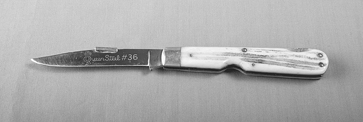
Hank’s Queen, 8½ inches overall length. HRC650
Lockbacks are knives where the blade locks into place once it is opened. The lock must be released before the blade can be closed. Usually this is done by pressing a spring on the back of the knife.
The fact that most knives did not lock led to a pretty good maneuver that was taught to me by a man who was at least sixty-five. I was seventeen. The move was simplicity itself: merely striking down with the open hand across the back of the blade held by your opponent. This caused the blade to close, cutting fingers when it was stopped by the hand. There was the simple and obvious counter of merely turning the knife so that the blade is edge up.
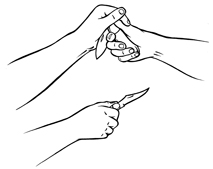
Striking down across the back of an opponent’s blade causes the blade to close, cutting fingers when stopped by the hand.
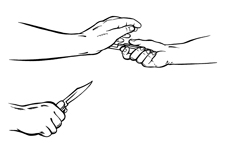
The obvious counter to the old man’s trick is to turn the knife blade edge up
The old man explained it to me and I just didn’t believe he could do it. I was considered pretty fast. I held a small stick and I knew what he was going to do and he did it anyway. I felt like a spastic snail.
I’ve always had a lot of respect for old people because some of them didn’t get that way by being timid. Some of them are just plain dangerous!
OPENING THE FOLDER
There are four basic ways to open a folder and we’ll deal with each in turn.
Most knives have springs that allow them to be popped open with a quick flick of the wrist. The blade is gripped tightly between thumb and index finger, and the hand is then snapped downward and back. With a little practice, this can be done in the space of a few inches, barely moving the hand.
The folding knife can also be opened by reversing the grip and holding the handle rather than the blade. This is harder to do because the blade has less mass than the handle. This also requires faster hand and arm movement and more room.
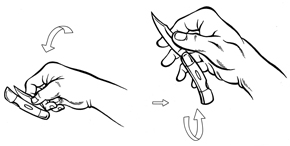
Popping open a folder by holding the blade (above) and by holding the handle (below).
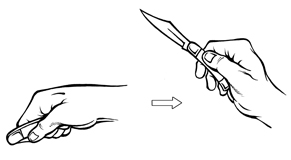
The most common method of opening a pocket knife was to thumb it.

Thumbing open a folder: start (left) to finish (right).
The knife is gripped by the thumb and middle finger with the pivot point of the knife (where the blade is hinged) pointing away. The little finger and the ring finger are on the sides of the knife handle. The thumb presses down and out, while the last two fingers pull back. This causes the blade to rotate forward into an open position. This operation can be sped up by snapping the wrist and imparting some momentum to the blade. This method involves a certain element of risk. If the thumb contacts the edge and moves along it, the result is a nasty cut. This is not only painful but it plays hell with the tough, macho image that should go along with the movement.
It is, however, possible to contact the edge with the thumb and not get cut. This requires that the thumb roll across the edge, exerting only a minimum amount of pressure and no forward movement at all. But it’s tricky and I certainly don’t advise trying it. Better to practice opening it with the thumb, putting pressure on the side of the blade and not contacting the edge.
One definite advantage to this style of opening is that it can be done quietly. By doing the movement slowly and gripping the knife very tightly, you can muffle the sound so that it can hardly be heard.
The third way to open a knife one-handed is also the easiest to master.

Third one-handed method.
Here, the knife is gripped by thumb and index finger, but the pivot point is jammed back against the ball of the thumb. The little finger is hooked on the side of the knife and presses down quickly. This can be done with no movement of the hand at all, only the fingers. The only disadvantage is that the knife must be shifted forward to get the hand off the blade.
Many of the people I’ve known to use this method also ground off the edge from about an inch back of the point. They don’t need to shift the grip then because all they had was a small sharp sliver of steel an inch long. They really never wanted to kill anyone, especially by accident. They just wanted to “cut ’em up a little.” (I had some really nice people for friends when I was young.)
I’ve saved the most practical and worthwhile method for last. You simply hold it with one hand and open it with the other. And you don’t make any mistakes.
KNIFE LENGTH
Now let’s talk about knife length.
Most states and cities have ordinances regarding the blade length of knives. Length regulations vary from place to place, often within the same state. Even the way the blade length is measured varies. In some places, it’s measured by cutting edge alone, while in others, it’s measured from the pivot point of the knife.
Generally, it’s considered illegal to carry any blade designed for offense or defense. I don’t know all the laws, not even in the city and state where I live, so I’m not going to give any legal advice at all. What I will talk about is the comparative effectiveness of blade lengths.
There’s a popular expression you can run across in many books: “The longer the knife, the bigger the punk!” Well, buddy, don’t you believe it. The longer the knife, the more dangerous it is to face. It’s not difficult to understand this, either. If their knife is longer than yours, they can cut you before you can cut them. A six-inch blade is vastly superior to one that is three inches long. But a six-inch blade is hurting when it’s up against one that’s eight inches long.
Having said that, I here have to say that the whole question of length is pretty nebulous. Somewhere in that range, length becomes less and less critical. It’s largely a matter of taste. It depends on where you carry the knife, whether it’s a folder or a fixed blade, and even how big you are. After all, a big man can more easily conceal a big knife.
What you have to keep in mind is the fact that a longer blade is just plain tough to go up against. This doesn’t mean you’re going to lose if the guy has a five-inch knife and yours is only three inches. It does mean you have to work harder to keep from getting hurt.
OTHER STREET WEAPONS
Knives aren’t the only things used as street weapons. Man is a pretty inventive animal, and if there’s one field where he really excels, it’s in the field of weaponry. Baseball bats, chains, sticks, bricks—all of these have been used, and it’s wise to remember them in case the need arises.
Although they are not really effective compared to a good knife, razors and ice picks are fairly popular, and they pack a lot of scare value into a relatively small amount of metal. Surprisingly, one of the most primitive weapons is also one of the best: a good solid hickory stick. It takes a lot of practice to overcome the tendency to merely use it as a club to hit with, but a good man with a stick is someone to be left strictly alone.
One of the most unusual and surprisingly effective weapons is a rolled-up magazine (Life had an ideal size and quality of paper for this).
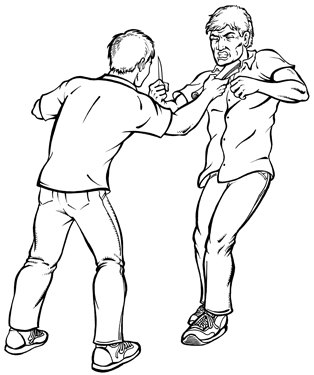
Many things can be used as street weapons. It’s amazing how much damage can be done with a rolled-up magazine.
Roll the magazine very tightly and then use it as a thrusting stick. It’s amazing how much damage can be done with such a weapon, especially when thrusts are directed at the nose, teeth, throat, solar plexus, and groin. You can roll it around the left arm and tape it in place, making an effective shield against both blows and cuts. Worn that way it could give real authority to an elbow smash.
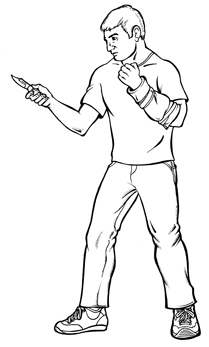
A magazine rolled around and taped to the left arm can make an effective shield.
I’ve seen some odd things used, but one of the oddest and dumbest I saw was when I was around nineteen. I knew a boy who was really hot after a couple of guys he felt had really done him wrong. He took an Irish potato, pressed a bunch of single-edged razor blades in it, edge out, then dropped it into a sock. He ran into the guys at a drive in, jumped out of his car cussing and swinging that sock. Everybody scattered because he was really swinging wild. He hit one guy on the shoulder, making some really nasty cuts. But then when he drew back, the sock bounced around and hit him in the back of the head. He yelped, jerked back and it bounced again and hit his hand. This time he dropped it and the other two closed in and damned near beat him to death.
I didn’t know any of the people involved personally. They were just faces I saw around. I heard someone went to jail, but I’m not sure who.
Now the sock and razor blades is a real nice idea, but any fool can see that you have to tie it to the end of a stick to keep it from turning on you. And you damned well better practice with it before you go using it for real.
This is not a book about unconventional and makeshift weapons, so I won’t be going into much detail about these things. But remember this: Almost anything can be used as a weapon when the need arises. What you have to do is look quickly and almost instantly evaluate the potential as a weapon of any object within reach. Flashlights and bottles are obvious, and a pencil or ball point pen makes a crude but effective stabbing instrument. A rock is not merely to throw, but can be used effectively as a hand ax. If you don’t have anything, grab something, even if it’s just your mother-in-law.